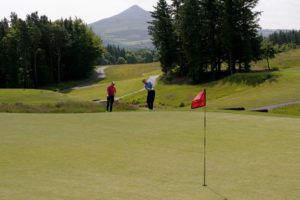The Real Value of a Practice Swing
In earlier articles I have written about the benefit of having a routine with our golf shots and how each phase can be beneficial in leading us to the point where our execution of the shot is in auto – pilot. When I discuss routines with students, practice swings are often mentioned as part of this process but I often think to myself “what is the real value of a practice swing?”
Over the years I have looked to see if much research has been done in this area of golf and up to date I haven’t come across anything that suggests that practice swings are good or bad for everybody. I have also thought about this process in relation to what other sports do and I can’t think of another sport that has clear physical rehearsals of actions that are part of a routine they use (I am not saying definitively there are no others it’s just that I cannot think of any).
There are however examples in certain sports like the technical disciplines in skiing of athletes using imagery as a preparatory tool before a race. There are a couple of theories around imagery as a rehearsal.
- Neuromuscular theory proposes that visualisation activates the same motor pathways as if the skill were physically performed. Studies using EMG equipment have demonstrated this activation but it happens at a lower level than the actual movements. Also practical studies have been carried out suggesting the same outcome.
- Cognitive theory suggests that imagery speeds up the acquisition of mental elements required for the performance of a skill. In other words we become better, quicker.
So the above would suggest some of the value of practice swings can be done in the head without actually going through the physical process. One thing is clear though – it says that Imagery and visualisation are very beneficial skills to have.
One student said to me recently that another coach told him “that he shouldn’t restrict his routine to one or two practice swings but that he should make enough practice swings until he got the right feel for the swing he was after”. No doubt the slow play police would have some comments but what this does suggest is having the right feel in our swing can be important. In fact I would go as far as saying that for me the real value of a practice swing is not to rehearse flawlessly the technique of a shot but to get a snapshot of the feel we need to execute the shot in our auto-pilot state. I think this is particularly important in chipping when the surface contact we make (brushing the turf) during our practice swings can be a great but simple trigger to the overall feeling we are looking for when executing the shot. This brushing of the ground with a simple and shortened swinging motion could also be very useful in our fairway shots even though the actual practice swing doesn’t represent the full technique of the swing we are going to use – it is more of a condensed trigger. So our practice swings don’t have to be perfect and for sure in some cases an exaggeration of a trigger feel can be the best way to use a practice swing, Miguel Angel Jimenez the Spanish golfer is a good example of this. His practice is quite different to the one he hits the ball with.
We are definitely not playing a game where “one size fits all” but I don’t think it will do any harm to consider what value you can or get from practice swings. If you are a golfer who makes the swings just for the sake of them perhaps you can start to link them into imagery skills to get better value from them. If you have poor striking let your practice swings make the surface contact you are looking for. It might even benefit your game to get rid of some practice swings if they offer no value for you.



